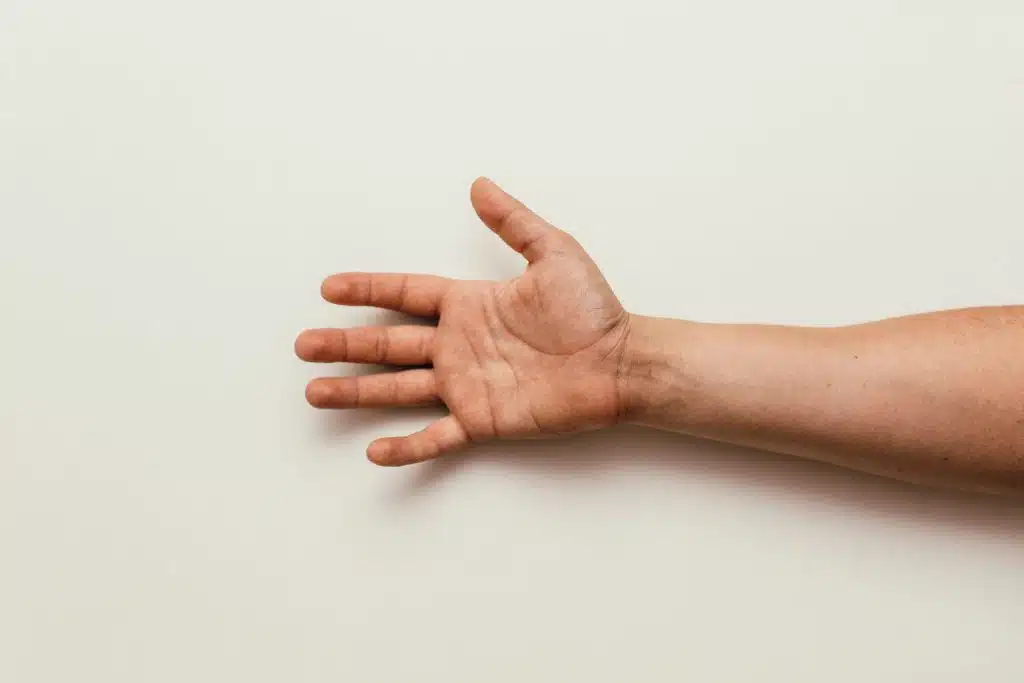A common form of pain people can develop as a result of physical work or repetitive physical motions in other areas of their lives, are tendinopathies. In this article, we’re going to be exploring the different forms of tendinopathies, also known as tendinosis, that can affect the tendons in the body. We’ll also explore how to deal with a tendon injury, and the types of treatments one can try on the path to healing.
Living with Tendinopathies – Ben’s Story
Let’s look at an example of what it can be like to live with tendinopathy pain, and how treatments like physical therapy are a way to help!
This is Ben’s story. Ben is an active 58-year-old, who loves to play golf on the weekends. Lately, he has been noticing that he has a shorter range of motion on his swing and pain in his forearm that is affecting his gameplay.
Ben tries to fix the tendon pain issue himself, massaging the affected area. However, this doesn’t help, and the pain continues to get worse and worse. Finally, he decides to see if a physiotherapist could do something to help.
At the physiotherapist, Ben gets a full assessment. His physio reviews his medical history, explores his tendonitis symptoms, and explains and diagnoses his problem. He soon begins treatment and pain management, which includes different physical therapy exercises. Soon enough, Ben is feeling better, and is back to golfing as normal!
If you’ve been dealing with tendinopathy pain, you deserve the same level of compassionate care as Ben. Luckily, clinics like Sydney Pelvic Clinic are here to help, and are able to address a number of general physio conditions!
What Is Tendinopathy?
Tendinopathy is a term that refers to different conditions that can occur in the body’s tendons as a result of overuse.
Tendons are the tissues in your body that work to keep your muscles attached to your bones. A tendon most people would be familiar with is a tendon like the Achilles tendon, which connects a person’s heel to their calf muscle.
Usually, tendinopathy can take the form of tendinitis or tendinosis.
Tendinitis refers to an inflamed tendon, which can be short or long-term. Tendinosis refers to tendon degeneration and a breakdown of collagen in the tendon, which happens as a result of repeated use of a specific tendon.
Types of Tendinopathy
As there are many different tendons found throughout the body, there are different kinds of tendon pain issues one can experience. Some of the more common ones include:
Achilles Tendinitis: Also called Achilles tendinopathy, this refers to pain, swelling, or tears in the Achilles tendon. This includes developing an Achilles tendon disorder, an Achilles tendon rupture, or other forms of Achilles tendon damage.
Rotator Cuff Tendinitis: People with this form of tendinopathy deal with pain in the rotator cuff, which covers a group of tendons located in the shoulder. Shoulder pain could indicate problems with these tendons, and/or the shoulder joint.
Patellar Tendinitis: This refers to damage done to the patellar tendon, located in the kneecap. This tendon connects the kneecap to your shin, and when damaged, can cause knee pain.
Lateral Epicondylitis: Commonly known as tennis elbow, this is a condition where there is a tendon tear or damage to elbow tendons.
De Quervain’s Tendinosis: This is a form of tendon inflammation that affects the tendon in the thumb and/or wrist, leading to pain while using your hands.
Medial Epicondylitis: Also called golfer’s elbow, this is a condition where a person has injured the tendon that connects a person’s forearm to the elbow. This kind of injured tendon is often caused by the repetitive movement done by golfers.
Tendinopathy Symptoms
Tendinopathy is indicated by the following symptoms:
- Pain and tenderness
- Difficulty moving certain joints
- Burning sensation in the muscles and/or tendon
- Loss of muscle strength
- Stiffness
- Swelling
- Cracking or grating sensations when moving joints
- Red, warm skin in the area that’s painful.
What Causes Tendinopathic Pain?
The most common cause of any kind of tendon pain or injury is repeated wear and tear on the tendon due to overuse. This can happen as a result of:
- Repetitive movement/use of tendons (ex/ lifting, shoveling, sports)
- Lifting weights that are too high for the tendon to handle
- Muscle imbalances
- Lack of strength or flexibility in the muscles/tendons
- Genetic conditions that affect muscle/tendon strength (ex/ diabetes, arthritis)
Tendinopathy Treatment
Different treatment approaches for tendinopathy include:
- Rest, combined with icing the tendons
- Physiotherapy strengthening exercises
- Massage therapy
- Anti-inflammatory drugs
- Compression garments
- Surgery (in more extreme cases)
Diagnosing & Treating Tendinopathy at Sydney Pelvic Clinic
The journey to treat your tendinopathy issues will begin with reaching out to a medical professional, like Sydney Pelvic Clinic! At our clinic, we’ll work to address your pain issues in the following ways:
Full Assessment
We start with a full assessment with your physiotherapist. This assessment will include collecting medical history, evaluating symptoms, and performing a physical assessment to address your pain level and range of motion.
Diagnose & Explain
After the full assessment, we will work on diagnosing and explaining the reasons behind your tendon pain problems. Your physio will discuss our findings with you fully, and explain all potential treatment options and their potential outcomes.
Begin Treatment
Once we have a plan of action, it’s time to start treatment! Sydney Pelvic Clinic will help you with a range of different treatments. These include strengthening exercises and other therapies aimed at encouraging pain relief and bringing strength and stability back to the injured area.
Get Help with Sydney Pelvic Clinic
If you have been dealing with tendinopathies pain, it’s time to take the steps towards tendon healing! If you click here, you can reach out to Sydney Pelvic Clinic for a consultation and get started. We’re ready and prepared to help you start living pain-free!

